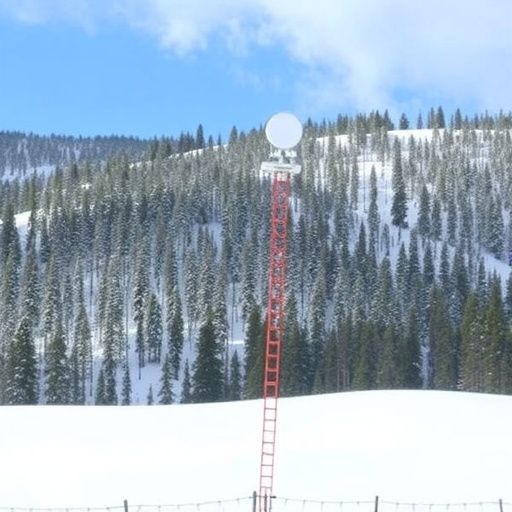In recent years, the significance of effective water supply forecasting has become increasingly pronounced as regions across the globe grapple with the repercussions of climate change and extreme weather patterns. The research conducted by Raleigh et al. (2025) arrives at a crucial moment, presenting innovative approaches to enhancing water resource management. Their study, titled “Snow monitoring at strategic locations improves water supply forecasting more than basin-wide mapping,” sheds light on a pivotal shift in how snow data can be utilized for more accurate forecasting methods.
Water supply is essential for both human consumption and agricultural productivity. Historically, traditional forecasting methods have emphasized broad basin-wide snow mapping. However, this approach often lacks the granularity needed to effectively predict water availability in specific regions. In their groundbreaking research, Raleigh and his colleagues propose that targeted snow monitoring at strategic locations can offer more precise data, ultimately leading to improved forecasting models. This revelation opens new avenues for water resource management in regions heavily dependent on snowmelt for their water supply.
The research team utilized a comprehensive strategy that incorporated field measurements, high-resolution satellite imagery, and advanced hydrological modeling. By integrating these methodologies, they were able to isolate and analyze the impacts of snow accumulations at selected monitoring locations rather than relying solely on the aggregated data from expansive basins. This fine-tuned approach enabled the researchers to assess snowpack dynamics more accurately, which proved crucial for predicting runoff and, consequently, water availability.
One of the standout findings from Raleigh et al.’s work was the considerable discrepancy between the accuracy of forecasts derived from localized monitoring as opposed to those generated from basin-wide assessments. The researchers demonstrated that snow data collected from strategically placed monitoring sites yielded forecasting results that were significantly closer to actual water supply conditions. This accuracy is essential for water managers who must make informed decisions about water allocations in agriculture, municipal use, and environmental sustainability.
The implications of this research extend far beyond the academic realm. For municipalities, the benefits of improved water supply forecasting could translate into more efficient water usage and conservation efforts. Rather than overestimating the available supply, which can lead to wasteful practices, or underestimating it, jeopardizing essential services, local governments can leverage these findings to enhance their water management strategies. This could help mitigate conflicts over water usage among various stakeholders, including farmers, urban planners, and conservationists.
Moreover, agricultural sectors, which are heavily reliant on accurate forecasting to plan irrigation schedules, stand to gain significantly from this research. Farmers often struggle to adapt to changing water availability due to unpredictable weather patterns, leading to reduced crop yields and economic losses. By implementing strategic snow monitoring, farmers could receive timely, localized information to make better irrigation decisions, ensuring crop viability and maximizing yield potential.
The study also emphasizes the importance of adopting new technological advancements in monitoring and forecasting methodologies. The fusion of high-resolution satellite imagery with field data exemplifies how technology can enhance traditional practices. By employing more sophisticated analytical tools, researchers can decipher complex environmental data and provide actionable insights that were previously unattainable with conventional techniques.
Aside from agricultural benefits, there are considerable environmental implications tied to improved water supply forecasting. Lakes, rivers, and ecosystems dependent on seasonal snowmelt are particularly vulnerable to shifts in water availability. Accurate forecasting allows for a better understanding of water distribution patterns, which is essential for preserving aquatic habitats and maintaining biodiversity. Implementing proactive water management strategies can aid in the prevention of ecological degradation caused by both droughts and floods.
Raleigh et al.’s research also raises crucial questions about the scalability of localized monitoring systems. While strategic monitoring has proven effective at certain sites, it remains to be seen how these methods can be applied across diverse geographical regions. Future research will need to explore the potential for establishing a network of localized snow monitoring stations that can cater to various regions’ unique climatic and hydrological characteristics.
Additionally, there is a pressing need for interdisciplinary collaboration among scientists, policymakers, and water resource managers. Implementing the findings of this research will require concerted efforts from various stakeholders. It presents an opportunity for discussions on integrating new methodologies into existing water management frameworks. By fostering collaboration, there is potential for a more comprehensive understanding of regional water systems.
In conclusion, Raleigh et al.’s research illuminates a promising path forward for improving water supply forecasting through strategic snow monitoring. It advocates for an evolved perspective toward water management that prioritizes localized data collection and analysis. As the world continues to confront the challenges posed by climate change and resource scarcity, adopting innovative approaches such as these will be paramount in ensuring sustainable water supplies for future generations. The study’s findings lay a crucial foundation that can help reshape the methodologies used in water resources management globally, marking a significant step toward more resilient and adaptive strategies in the face of environmental uncertainties.
The insights gleaned from this research are not just applicable today; they will serve as a critical reference point for future studies looking to push the boundaries of what is possible in the realms of environmental science and water resource management. With the pressing necessity for accurate predictions of water availability more important than ever, Raleigh et al.’s work provides a compelling case for rethinking the traditional paradigms of snow monitoring and its implications for society as a whole.
Subject of Research: Water supply forecasting and snow monitoring techniques.
Article Title: Snow monitoring at strategic locations improves water supply forecasting more than basin-wide mapping.
Article References: Raleigh, M.S., Small, E.E., Bair, E.H. et al. Snow monitoring at strategic locations improves water supply forecasting more than basin-wide mapping.
Commun Earth Environ 6, 665 (2025). https://doi.org/10.1038/s43247-025-02660-z
Image Credits: AI Generated
DOI: 10.1038/s43247-025-02660-z
Keywords: water supply forecasting, snow monitoring, hydrological modeling, climate change, resource management.




